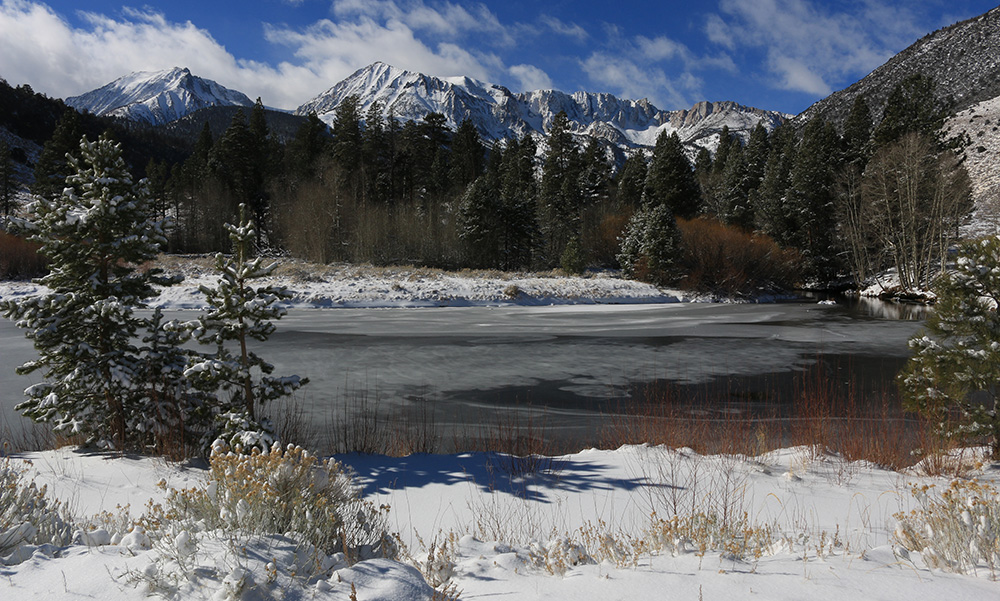
A wet winter has brought needed relief to a drought-stricken Mono Lake. However, a glimpse at Lee Vining weather data reveals that predictions about climate change in California and the Sierra Nevada are becoming real.

Warming temperatures, along with more extreme and less-frequent precipitation, are reflected in our local weather. The record-setting drought of the last five years still casts a shadow across the Mono Basin. Multi-year impacts to the watershed and ecosystem have accumulated due to record high temperatures, remarkably low runoff, and wildfires. As climate forces further change, monitoring, assessment, and adaptation will be critical to the future restoration and protection of Mono Lake.
The soggiest month
This January set a record for the wettest month in Lee Vining’s weather data history. For three decades, Mono Lake Committee staff have been recording daily temperature and precipitation data at a National Weather Service cooperative weather station. In January, the station registered 11.23 inches of precipitation, beating out all previous January totals by a wide margin and topping the previous all-time wettest month of 9.85 inches (March 1995). January in Lee Vining is, on average, the wettest and coldest month of the year. While snowfall was impressive during the month, snowfall alone did not set a record. Atmospheric river events brought high snow levels and significant rain. Warmer and wetter storms with higher snow levels continued through the first two-thirds of February. The unusual amount of rain is a reminder that, while there may be snowy years even in a warming climate, Lee Vining is at an elevation (6,780 feet) where small increases in sea surface and atmospheric temperatures will translate into more winter rain.
Climate change research suggests that precipitation in California may become more intense and variable, with longer dry stretches. Local weather data reflects this. In the last 19 months, Lee Vining has set three all-time high calendar month precipitation records: May and July 2015, and January 2017. These record months appear within extreme drought and since the historically-low Mono Basin snowpack and runoff of 2015.
Warming in the numbers
Average temperatures have been increasing in California since the 1980s. Every climate division in the state shows warming in the long-term data. Lee Vining weather data also points to warming. In 2016 there were a record 18 days at 90°F or higher, topping the previous record of 14 days in 2002. Since 2006, the annual average number of days at or above 90°F has nearly doubled from 4.2 to 8.2. Warmer winter days are also on the increase. In 2015 there were a record 14 days during January and February that were 60°F or higher; in 2016 there were 7 days. From 1989 to 2005, the average was 0.4 days. In the last ten years that average has increased almost sevenfold to 2.7 days in January and February. Looking back over five years of temperatures in town, 48 of the last 60 months have been warmer than average.
Precipitation and lake level
One of the questions we hear often is “what will happen to Mono Lake with climate change?” There is no simple answer, and it’s a broad and complicated subject depending on which aspect of the lake you’re talking about—ecosystem, tributary streams, or lake level. Despite the recent punishing drought, which reduced the lake level by nearly 7 vertical feet, we still expect Mono Lake to continue a long-term trek to its management level. Mono Lake has a management plan that includes reduced diversions during drought conditions, and wet years have the capacity to quickly erase lake level deficits caused by drought. For example, during a very wet 1995, Mono Lake rose 3.5 feet, reversing the impact of previous dry years. Both rain and snow run off and eventually reach Mono Lake but it’s the quantity of precipitation over many years that matters for lake level. Increasing temperatures do increase evaporation, but this may have less of an impact on lake level compared to small increases or decreases in overall annual precipitation and runoff. We will probably see more intense droughts in the decades ahead, but it’s also possible we will see more intense precipitation when it does occur. How this affects Mono Lake over the years is uncertain; this year’s April 1 lake level reading and snowpack measurements will be important data points for Mono Lake after five years of drought.
Runoff timing still matters. Mono Basin streams formed over the millennia with a winter snowpack that melted off gradually through the summer months. Hydropower and diversion infrastructure was engineered to work with this natural hydrograph too. As warming temperatures, earlier runoff, and extreme precipitation events occur, the entire watershed undergoes change from the alpine regions to the Mono Basin bottomlands. The task of restoring the streams becomes increasingly difficult and management challenges multiply as the amount and timing of water passing through dams, reservoirs, and diversion infrastructure changes.
Science pathway
Climate change poses challenges to the protection and restoration of Mono Lake. Relatively small annual increases in temperature or changes in hydrology can alter underlying chemistry and physics and the biological systems they support. From bacteria, to bitterbrush, to birds, the ecosystem we have known at Mono Lake and in the Eastern Sierra will shift with the climate. Determining the character and degree of these changes, and understanding the best way to adapt to them, will require continued monitoring, science, and collaboration.
Making the best cooperative decisions with the best information available is part of the legacy of the Mono Lake Committee. Continuing that tradition is one of the many ways the Committee will adapt to climate change too. We will continue to operate a small field station, support research, conduct analysis and forecasting, and gather important data, including weather data, in downtown Lee Vining.
This post was also published as an article in the Winter & Spring 2017 Mono Lake Newsletter (pages 8 and 24).
